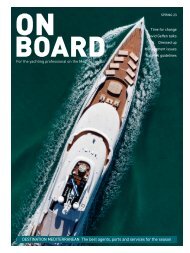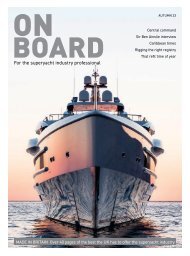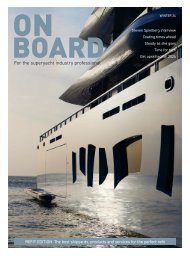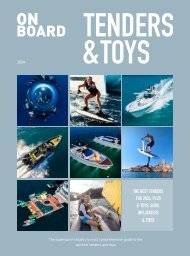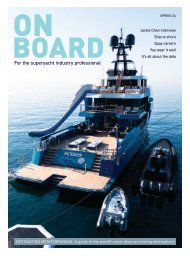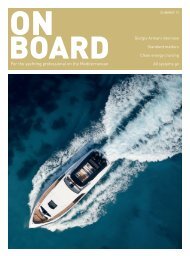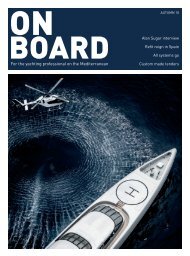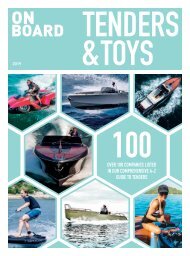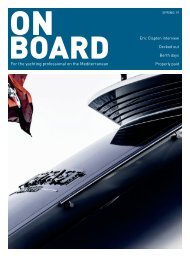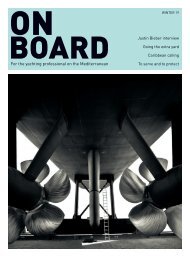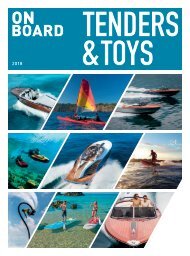ONBOARD Magazine TENDERS & TOYS 2021
Create successful ePaper yourself
Turn your PDF publications into a flip-book with our unique Google optimized e-Paper software.
POWERBOAT SAFETY
BY DAY AND NIGHT
Philip Godwin RYA
Advanced Powerboat &
Yachtmaster Instructor
looks at the benefits of
the RYA Tender Operator
Course
The qualification most requested by
the yachting industry for using a
yacht tender is the RYA Powerboat
Level 2. This qualification covers the skills
needed to handle a small powerboat such
as coming alongside, man overboard, safety
and regulations.
This course is great for anyone starting out in
the industry, but it is not specifically geared
towards the more demanding situations that
deck crew are often faced with, such as
operating at night and embarking passengers.
Further training courses have been developed
to fill the gap between Powerboat 2 and
Yachtmaster training which many deck crew
go on to later in their careers.
The RYA Tender Operator was specifically
developed for yacht crew engaged in
transporting guests form yacht to shore. The
course aims to further the skills learnt on
the RYA Powerboat 2 by placing students in
more demanding situations. For instance, on
a typical Powerboat 2 course a student would
be taught to dock alongside the fuel berth
inside a port. On the RYA Tender Operator
course a student might be asked to berth
alongside a typical quay for restaurant in an
open bay. Further discussion and training
would include how to ensure guests could
then be disembarked safely from there.
The RYA Tender Operator course moves
onto planning coastal passages, by day and
night. It also includes search patterns. It
is often taken by the operators of chase
boats and larger tenders that operate at
longer distances from their ‘mother ship’.
The use of electronics, such as chart
plotters, is covered on both courses. It
is recognised that these are not always
fitted to a yacht tender, so the courses
also teach the importance of traditional
pilotage and route planning.
TOP TIPS FOR SAFE TENDER OPERATION BY
DAY AND NIGHT
We have compiled our top tips that we
emphasise on these courses.
1. Controls
Check that the vessels engines function
correctly. They should not start in gear and
the kill cord should work. Kill cords should
always be worn. The preferred method is
around the leg where it does not become
tangled with steering etc. and will not slip off.
It is also worth having a procedure that
the boats helm station should never be
left unattended whilst the engines are
running. A possible scenario could be that
whilst the helm is helping a guest onboard
the vessel is accidentally ‘knocked’ into
gear with disastrous consequences! Not
all small craft have the ‘interlock’ which
keeps the controls in the neutral position
and modern electronic controls only need
a feather light touch.
2. Safety equipment
The vessel’s safety equipment should be
easily accessible. Too often the safety grab
bag is stowed under seating which is difficult
to access. A throwing line should be kept
ready, and at night a search light. Whilst
the guest tender should look aesthetically
correct, it’s advisable to spend some time
planning how the equipment might be used
and stored so it is ready immediately.
3. Make sure you have a plan!
A passage plan is required by the SOLAS
regulations for even the simplest and
shortest of journeys. A sketch can be used
or with headings and notes on any hazard,
and land/sea marks which can be used to
aid navigation. The plan should be easy to
read and follow, and at night should take
account of any unlit marks/buoys. This plan
and the ETA should be logged with the bridge
before leaving the vessel.
12 | TENDERS & TOYS | ONBOARD



